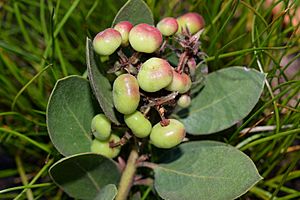Monterey manzanita facts for kids
Quick facts for kids Monterey manzanita |
|
|---|---|
 |
|
| Scientific classification | |
| Kingdom: | |
| (unranked): | |
| (unranked): | |
| (unranked): | |
| Order: | |
| Family: | |
| Genus: | |
| Species: |
A. montereyensis
|
| Binomial name | |
| Arctostaphylos montereyensis Hoover
|
|
Arctostaphylos montereyensis is a special type of plant called a manzanita. People also call it the Monterey manzanita or Toro manzanita. This plant is quite rare! It only grows in a small area in Monterey County, California. You can find it in places like Fort Ord and Toro County Park, which are near Salinas. It likes to grow in sandy soil in an area called chaparral, which is a type of shrubland often found near the coast.
Contents
What Does the Monterey Manzanita Look Like?
This manzanita is a shrub, which means it's a woody plant smaller than a tree. It can grow to be about one to two meters tall. That's like standing next to a tall person or even a small car! Its branches, called twigs, are covered in tiny, stiff hairs, making them feel bristly. They also have small glands, which might make them feel a bit sticky.
Leaves and Flowers
The leaves of the Monterey manzanita are a dark green color. They feel rough and bristly, just like the twigs. Sometimes, they even have a waxy feel. Each leaf is about 2 to 3 centimeters long. They are shaped like a circle or an oval and have smooth edges.
When the plant blooms, its flowers grow in a tight group called an inflorescence. These flowers are shaped like tiny urns, which are like small vases.
Fruit and Seeds
After the flowers, the plant produces a fruit. This fruit is a type of drupe, which means it has a hard pit inside, like a peach or a cherry. The fruit is about one centimeter wide. It's also bristly and glandular, just like the twigs.
Where Does the Monterey Manzanita Live?
The Monterey manzanita is an endemic plant. This means it naturally grows only in one specific place in the world. For this manzanita, that place is Monterey County, California. It's known from only a few spots in this county. These areas include parts of Fort Ord and Toro County Park, which are both close to the city of Salinas. It prefers to live in a type of habitat called maritime chaparral. This is a shrubland that grows near the coast and has sandy soils.

